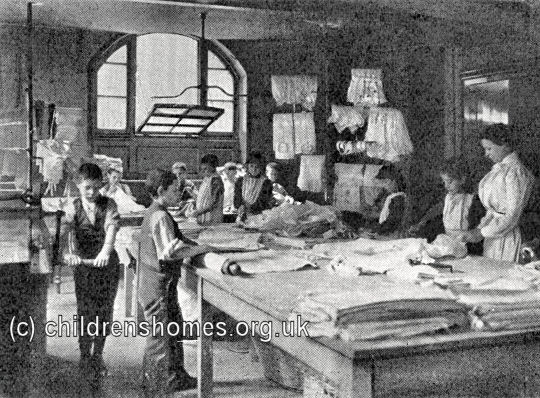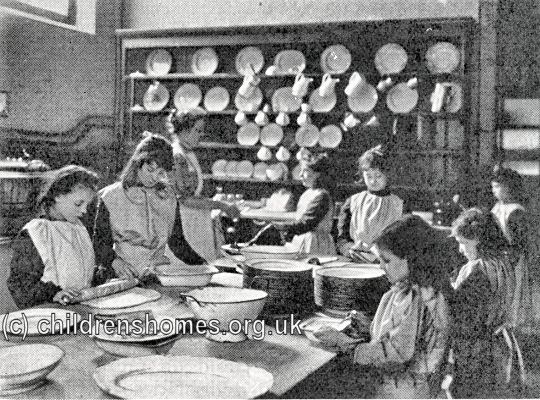London School Board / LCC Day Industrial School, Drury Lane, London
On August 23rd, 1895, the London School Board's Day Industrial School at Goldsmith (now Stukeley) Street, Drury Lane, Covent Garden, was formally certified to begin operation. The Day Industrial School provided a compromise between the residential Industrial School and the ordinary day school. Magistrates could order children to attend a Day Industrial School, and it was most commonly used for those whose family or other circumstances had resulted in their inadequate attendance at an ordinary school. Drury Lane was the Board's first such School and, in the face of long-standing opposition by some Board members, was established on an experimental basis, to evaluate the usefulness of such institutions for the metropolis.
The School, which could accommodate up to 200 children, was opened in the former Drury Lane Board School whose attendance was diminishing and whose pupils could be accommodated at other schools in the area. The first superintendent was Mr Thomas Humphreys.
In its new role, the School provided all of each child's meals, together with education and industrial training. It operated between 8 a.m. and 6 p.m. (with a half-day on Saturday) although the children would arrive as early as six in the morning. Up until breakfast time, they could play in the playground or, under the supervision of an officer, swim in the swimming bath. After breakfast and the morning ablutions, school work and industrial occupations took place in parallel until midday. The next half hour was devoted to drill and gymnastics, followed by a period of play, then dinner and a little more play. The afternoon followed a similar pattern except that those who had been doing school lessons in the morning were now occupied in industrial activity, and vice versa.
The boys at the School received instruction in woodworking, shoemaking and, from 1901, printing. Drury Lane was in the midst of the printing quarter of London and some knowledge of the trade provided useful employment opportunities. The girls received a thorough training in laundry work, together a wide range of domestic skills such as darning and mending, bed making, laying a fire, dusting, how to buy and cook food, how to look after a baby, and so on. Physical exercise also formed part of the daily curriculum for both boys and girls and the School acquired a set of portable gymnastic apparatus. Regent's Park was used for football and cricket. A boys' brass band was introduced in 1904.

Drury Lane Day Industrial School laundry, early 1900s. © Peter Higginbotham
One of the chief attractions of the School was the food provided. The dinners consisted of roast or stewed meat with vegetables two or three times a week, pudding twice, and fish on Fridays. Sometimes on Saturday, the menu consisted of bread and cheese and onions. The food was not, however, free of charge. The court order committing a child to attend the School specified the amount parents were required to pay, which varied from 6d. to 2s. a week.

Drury Lane Day Industrial School preparing dinner, early 1900s. © Peter Higginbotham
The Drury Lane School was deemed to be a success and the London School Board subsequently established two further Day Industrial Schools: at Poplar in 1901 and Nine Elms in 1902.
On May 1st, 1904, control of the School passed to the London County Council who took over the work of the London School Board on that date.
The Drury Lane School was officially closed on December 7th, 1921, with Thomas Humphreys still in post as superintendent. The buildings no longer survive.
Records
Note: many repositories impose a closure period of up to 100 years for records identifying individuals. Before travelling a long distance, always check that the records you want to consult will be available.
- The
Ancestry UK
website has two collections of London workhouse records (both name searchable):
- The Find My Past website has workhouse / poor law records for Westminster.
- London Metropolitan Archives, 40 Northampton Road, London EC1R OHB. Holdings include: Admission and discharge registers (1901-1921); Licence and discharge registers (1898-1921).
Bibliography
- Higginbotham, Peter Children's Homes: A History of Institutional Care for Britain's Young (2017, Pen & Sword)
- Mahood, Linda Policing Gender, Class and Family: Britain, 1850-1940 (1995, Univeristy of Alberta Press)
- Prahms, Wendy Newcastle Ragged and Industrial School (2006, The History Press)
Links
- None noted at present.
Except where indicated, this page () © Peter Higginbotham. Contents may not be reproduced without permission.


